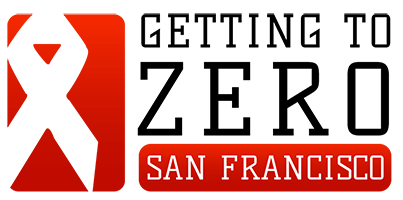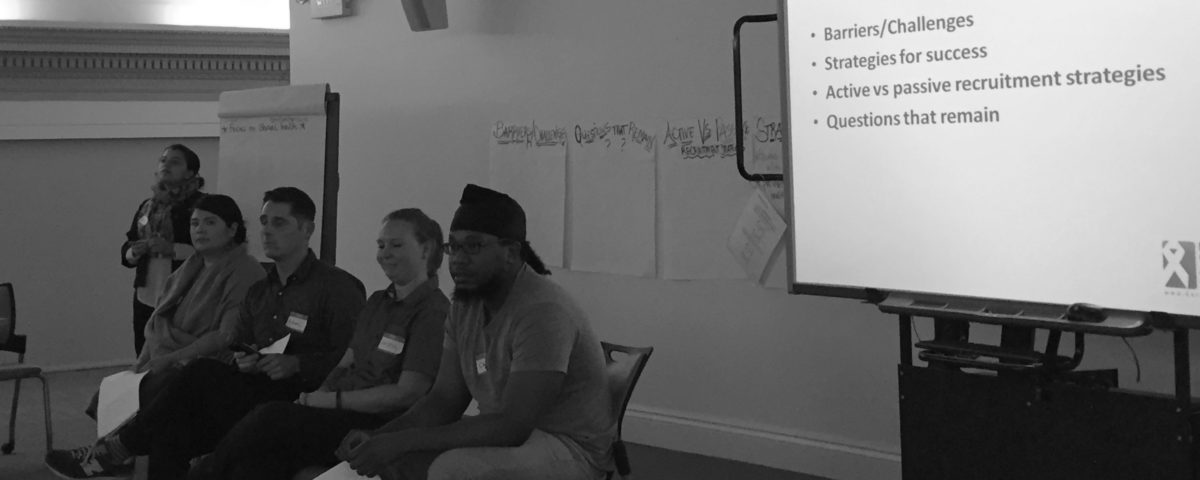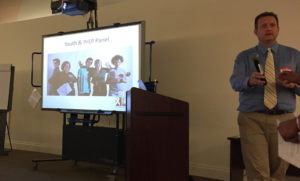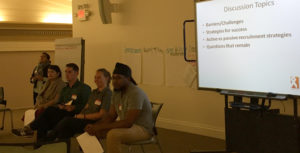PrEP for Youth Panel Discussion

PrEP for Youth Live Hangout 4/7/16
March 31, 2016
HIVE presents Frameworks for Getting to Zero
April 29, 2016PrEP for Youth Panel Discussion
By Tapakorn Prasertsith
The most recent Getting to Zero Consortium meeting, held Thursday, March 24, focused on an issue health providers have been facing since PrEP was approved in 2012: providing PrEP to youth.
PrEP currently is not FDA-approved to be prescribed for minors (<18 years old). This means providers can only prescribe to youth off-label, and insurance will not always cover off-label prescriptions. Given the high retail cost of Truvada (around $1,500 for a 30-day supply at the time of writing), affordability without medical coverage is virtually impossible, especially for this age group.
Why is this so important? It has been reported that in recent years, young men between the ages of 13–24 who have sex with men account for around 22% of new HIV transmissions. PrEP is an invaluable tool for HIV prevention, and ensuring the populations at highest risk have access to it is key to Getting to Zero’s mission.
Those under 26 are now commonly covered by their parents’ insurance. Therein lie issues of confidentiality and ensuring that youths’ safety and privacy are protected.
Thursday’s meeting included a panel consisting of specialists in the fields of sexual health and youth access to medical care:
- Sylvia Castillo, Manager of Public Policy & Community Engagement at California Family Health Council, working to promote their platform to ensure access to quality, comprehensive sexual and reproductive health care in Northern California
- Adam Leonard, Nurse Practitioner with San Francisco Department of Public Health specializing in adolescent and young adult health, working in Community Health Programs for Youth caring for 12–24-year-olds at Larkin Street Youth Services and Cole Street Clinic at Huckleberry Youth Health Center
- Kristin Kennedy, CRUSH (Connecting Resources for Urban Sexual Health) Project Coordinator, previously supporting linkage and retention in care for HIV-positive youth in Jacksonville, Florida, while delving into their personal narratives to understand what it meant to be young, black, gay/trans/queer, and living with HIV in the South
- David Carter, Scientific Liaison to CRUSH’s Community Advisory Board and student at San Francisco State University, being with the project since its inception and pilot phase in 2013 and working to provide a voice for young black gay men in the East Bay
Each panelist presented some background on what they do and how it relates to PrEP and youth, noting their own findings and struggles. Slides from the evening’s presentations can be found here. After the panel presentation, the audience was invited to ask questions on the subject.
Castillo described California’s Confidential Health Information Act (CHIA), which can help protect youth’s confidentiality when seeking PrEP services. For youth aged 12–26 who are covered under their parents’ insurance, parents may be sent written communication from the insurance company about services provided to youth (e.g., Explanation of Benefits), which could compromise the youth’s privacy and safety. Under the recently passed CHIA, youth can block this information being sent to their parents and instead have it sent directly to them.
Castillo recommended that youth file and confirm a Confidential Communications Request (CCR), which can be done at www.myhealthmyinfo.org, prior to initiating PrEP services, and to choose the option to block information about all health services. Insurance companies are held accountable and can be fined and sued for notable amounts for breaking patient requests to keep health insurance use private, a concern for those under their parents’ insurance.
Also at issue is share-of-cost information, especially since for Truvada this will typically show as $1,000 or more. With a CCR in place, this information is blacked out and sent elsewhere, but some advocacy and systems work still needs to be done in terms of share-of-cost reporting.
Leonard described the California Minor Family Code §6926, which states, “a minor 12 years of age or older may consent to medical care related to the prevention of a sexually transmitted disease.” Leonard confirmed that this law covers the provision of PrEP and highlighted that under this code, providers cannot disclose information about this care to parents/guardians without the minor’s consent.
He also mentioned that Family PACT, a state-administered program providing comprehensive family planning services to eligible low-income residents, can cover the cost of PrEP-related office visits and some lab tests (including HIV testing) and birth control methods; this has been useful for youth seeking PrEP, although PrEP medication coverage and some lab tests are not covered under the program.
Kennedy and Carter presented on CRUSH’s approach to provide youth-friendly services to HIV-positive and HIV-negative youth. Youth-focused “in-reach” through clinical staff and participant word of mouth have been more effective than traditional outreach methods for CRUSH recruitment, and offering flexible appointment slots and having non-judgmental front-line staff were key to providing culturally competent care for youth.
CRUSH has a robust community advisory board, a key component of the program, and has ensured development of culturally appropriate outreach materials, including highly engaging CRUSH webisodes at www.crush510.org.
 One concern raised during the audience discussion was whether youth are educated on the HIV epidemic—Are they taking it seriously? Is there still fear? Do they care? The CRUSH Project panelists responded that the HIV epidemic is touched on, but the priority is getting folks into routine sexual health care. They mention the past but truly want to focus on present-day care and, of course, tailor the conversation to each client’s needs.
One concern raised during the audience discussion was whether youth are educated on the HIV epidemic—Are they taking it seriously? Is there still fear? Do they care? The CRUSH Project panelists responded that the HIV epidemic is touched on, but the priority is getting folks into routine sexual health care. They mention the past but truly want to focus on present-day care and, of course, tailor the conversation to each client’s needs.
For those under 18, paying for PrEP can be a challenge, as the Gilead medication assistance program does not cover the cost of PrEP for youth under the age of 18, due to the current FDA labeling for Truvada PrEP. However, the discussion garnered some hope on what seemed like an insurmountable task.
There exist an emergency fund that uses copay cards and limited payment assistance programs, but these aren’t meant to completely cover high-cost items. They could be useful to get youth on PrEP for a couple of months, but given Truvada’s high cost, a couple of months’ coverage is lucky at best; these programs are generally used for PEP, as it entails only a 28-day supply.
New information came from the audience that Gilead, Truvada’s manufacturer, would be willing to supply PrEP for youth under 18, but only if it is done as a demonstration project. This led to wondering what we could find out from this hypothetical project. A lot of positive feedback was generated around the idea, opening up possibilities to dispense on-site like birth control and to get youth voices out.
It was mentioned that youth like partaking in studies, particularly for the incentives. This was part of the appeal of CRUSH and their experience as well, allowing them to collaborate with different organizations and create a social aspect to the experience, something helpful in retention and engagement.
A concern was noted regarding what would happen when such a project ends and research money runs out.
Another topic discussed was social media and technology engaging youth. Grindr was mentioned as a possible path to do outreach around PrEP through paid ads, but it was seen as having limited capacity for getting information out. Such ads could, however, plant seeds of thought into the minds of people who might eventually come in for PrEP or PEP.
Texting was seen as key in supporting adherence and good relationships with young patients. Panelists and audience members alike mentioned how much texting improved client retention for youth. It’s worth noting that this must be done in a HIPAA-compliant manner, as sensitive information is being transmitted in text messages through insecure lines; therefore, before pursuing text-based health messaging, it was encouraged to ensure HIPAA compliance.
Finally, it was announced that after much study and trial, several youth clinics in SF—Dimensions Clinic, Larkin Street Youth Services, and Huckleberry Youth Clinic—are able to utilize different methods, through MediCal, the Patient Access Network, and the Patient Advocate Foundation, to pay for PrEP for those under 18.
For those worried about confidentiality, it is recommended to go to myhealthmyinfo.org to get a comprehensive overview of one’s privacy options.
These resources, combined with hope from Gilead to support a demonstration project for youth, will go a long way toward Getting to Zero gathering tools to tackle a weak spot we have been burdened with since the beginning.




